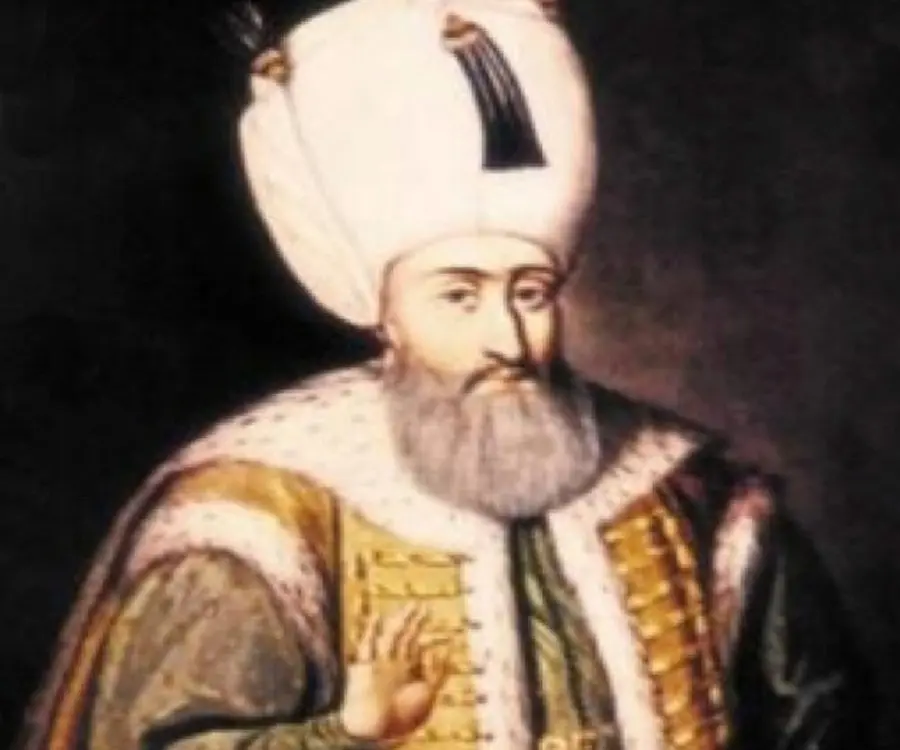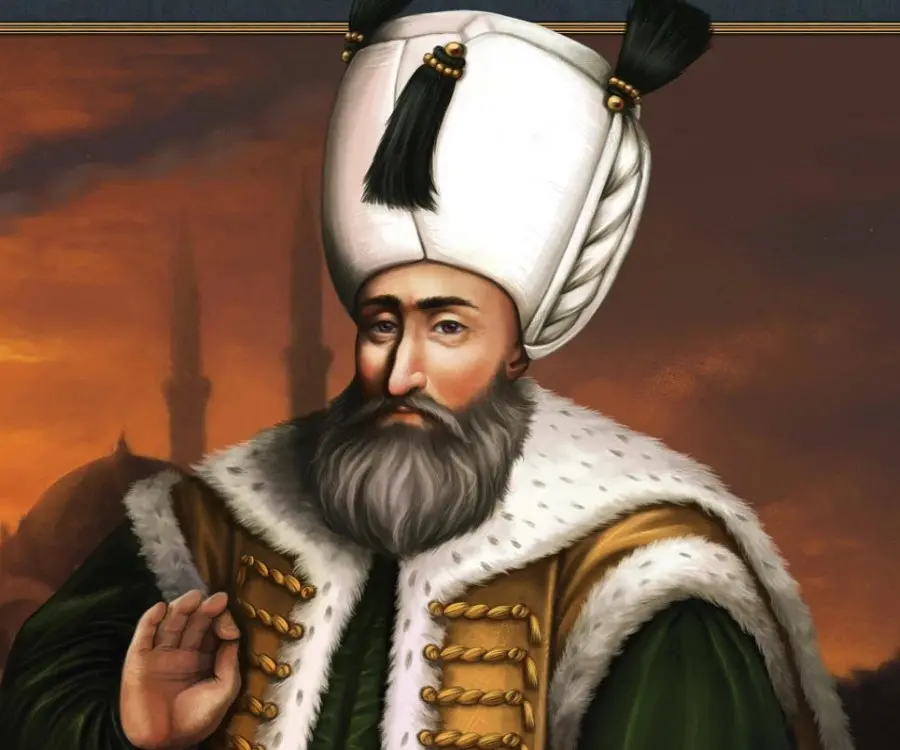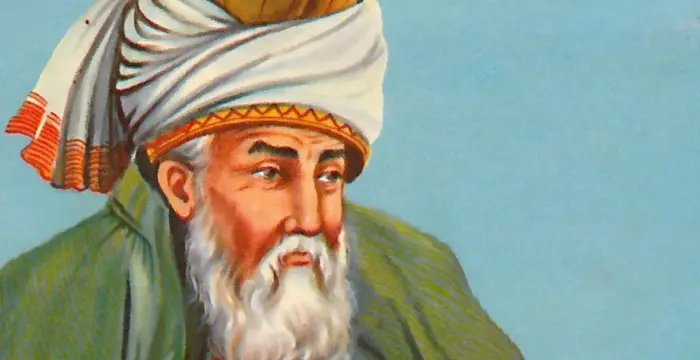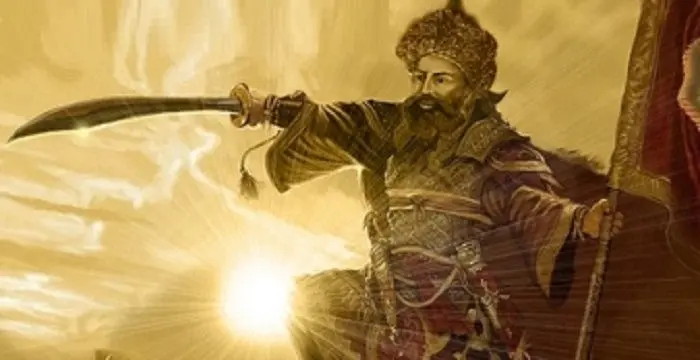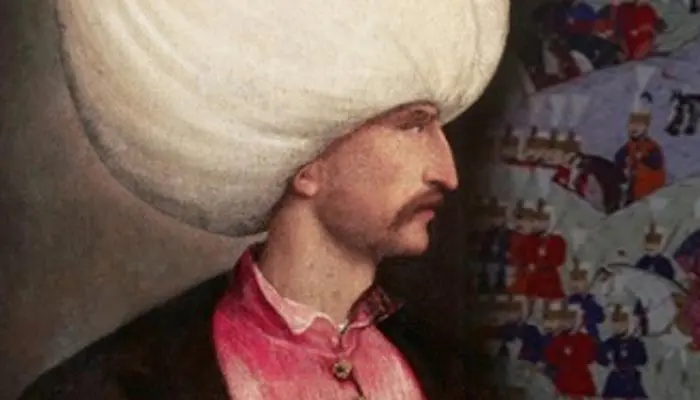
Suleiman The Magnificent - 10th Sultan of the Ottoman Empire, Birthday and Childhood
Suleiman The Magnificent's Personal Details
Suleiman I, commonly known as Suleiman the Magnificent, was the tenth and longest-reigning sultan of the Ottoman Empire
| Information | Detail |
|---|---|
| Birthday | November 6, 1494 |
| Died on | September 6, 1566 |
| Nationality | Turkish |
| Famous | Historical Personalities, Emperors & Kings, 10th Sultan of the Ottoman Empire, Emperors, Kings, Turkish Men |
| Spouses | Hürrem Sultan (also known as Roxelana), Mahidevran |
| Known as | Suleiman I, Süleyman, Kanunî Sultan Süleyman or Muhteşem Süleyman |
| Childrens | killed by his brother Selim with the support of his father in 1561), Mihrimah Sultan (1522-1578), Raziye Sultan, Şehzade Abdullah (born 1523 - 1525), Şehzade Bayezid (born 1525, Şehzade Cihangir (1531-1553), Şehzade Mehmed (1521-1543), Şehzade Mustafa (born 1515, Sultan Selim II (1524-1574) |
| Birth Place | Trabzon, Ottoman Empire |
| Religion | Islam |
| Gender | Male |
| Father | Selim I |
| Mother | Hafsa Sultan |
| Sun Sign | Scorpio |
| Born in | Trabzon, Ottoman Empire |
| Famous as | 10th Sultan of the Ottoman Empire |
| Died at Age | 71 |
Suleiman The Magnificent's photo
Who is Suleiman The Magnificent?
Suleiman I, famous as Kanuni (The Lawgiver) in his kingdom and Suleiman the Magnificent in the Western world, was the tenth sultan of the Ottoman Empire. He ruled the kingdom for over four decades marking the longest rule in the history of Ottoman Empire and emerged as a leading ruler of Europe during 16th century. He led his army in expanding the empire including conquering Rhodes and Belgrade, the Christian dominated regions; much of Hungary; huge areas of North Africa. His conflict with the Safavids saw him conquering many parts of the Middle East. The Ottoman Navy had an upper hand on the seas starting from Persian Gulf to Mediterranean and Red Sea. While at the helm of his empire’s political, military and economic power, he introduced important legislative reforms with regard to education, taxation, society and criminal law which marked a synchronization of the two kinds of Ottoman law, the Sharia (religious) and the Kanun (sultanic). A connoisseur of art and architecture, and a gifted goldsmith and poet, Suleiman I played an important role in developing the empire in the fields of art, architecture and literature thus marking the “Golden” era in the civilisation of Ottoman Empire.
// Famous Kings
Sundiata Keita
Sundiata Keita was the founder of the Mali Empire in West Africa. This biography profiles his childhood, early life, struggles, founding of empire, rule, administration, achievements and also gives some fun facts.
Ashoka
Ashoka was the third emperor of the Mauryan Dynasty and ruled almost the entire Indian subcontinent. This biography profiles his childhood, life, reign, achievements and timeline
Murad IV
Murad IV was one of the mighty Sultans in the history of the Ottoman Empire. This biography profiles his childhood, family, accession, rule, administration and timeline.
Childhood & Early Life
Suleiman I was presumably born on November 6, 1494, in Trabzon, Ottoman Empire to Şehzade Selim, who later became Sultan Selim I, and his wife, Hafsa Sultan, a converted Muslim, as their only son.
When he was seven years old he was sent to the regal schools of the ‘Topkapı Palace’ in Constantinople (modern-day Istanbul) where he studied literature, history, science, military tactics and theology.
In his youth he became friend with a slave Pargalı Ibrahim. Ibrahim later emerged as one of the most trustworthy advisors of Suleiman I who inducted him as the first Grand Vizier of the Ottoman Empire during the latter’s reign.
During the rule of Bayezid II, Suleiman I’s grandfather, he was made the sancak beyi (governor) of Kaffa in Crimea at the age of seventeen. He also became the governor of Manisa during his father’s reign.
Accession
After his father’s death on September 21/22, 1520, he became the tenth Sultan of the Ottoman Empire on September 30, 1520.
According to the Venetian envoy Bartolomeo Contarini, 'Suleiman was friendly, good humoured, enjoyed reading, knowledgeable and made good judgments'.
According to some sources, he was an admirer of Alexander the Great and was inspired by the latter’s vision of developing a world empire comprising the West and the East.
Campaigns & Conquests
His early crusades saw him personally leading the Ottoman army to vanquish the Christian strongholds in the Mediterranean and central Europe. These included invasion of Belgrade in 1521 and Rhodes in 1522.
He also conquered most of Hungary in the Battle of Mohács, one of the most significant battles in the history of Central Europe that took place on August 29, 1526.
He defeated the Hungarian King, Louis II, in the Battle of Mohács and after childless Louis II was killed in the battle, his brother-in-law, Archduke Ferdinand I of Austria, claimed the vacant throne of Hungary and succeeded in winning recognition from western Hungary.
On the other hand, a noble, John Zápolya, who also claimed the throne, was recognized as a vassal king of Hungary by Suleiman I. Thus, by 1529, Hungary was divided into Habsburg Hungary and the Eastern-Kingdom of Hungary.
Suleiman I’s first attempt to conquer the Austrian city of Vienna in what is famous as the ‘Siege of Vienna’ that occurred from September 27 to October 15, 1529 was an indication of supreme helm of the Ottoman Empire as well as the extent of its expansion in central Europe.
Christian Coalition victory concluded the siege with Suleiman I failing to conquer Vienna in the face of resistance from the Christians complimented with bad weather, inadequacy of supplies and bogged down war equipments.
He met with same fate while making his second attempt in overtaking Vienna in the Siege of Güns that occurred from August 5 to August 30, 1532.
Meanwhile, he focussed on the ongoing threat inflicted by the Persian Shi'a Safavid dynasty. Two incidents triggered conflicts between the two empires - assassination of Baghdad governor, who was loyal to Suleiman I, on the order of Shah Tahmasp, and change of loyalty of governor of Bitlis towards Safavids.
The first campaign between the two Iraqs saw Suleiman I ordering Grand Vizier Pargalı Ibrahim Pasha in 1533 to attack Safavid Iraq resulting in recapture of Bitlis and capture of Tabriz. Pasha was then joined by Suleiman I in 1534 that resulted into the capture of Baghdad by the Ottomans.
His reign saw dominance of Ottoman navy in the Persian Gulf, Red Sea and the Mediterranean. In 1538, Khayr al-Dīn, famous as Barbarossa in the West, was made admiral or kapudan of the Ottoman fleet, succeeded in winning the Battle of Preveza against the Spanish navy. This helped them in securing eastern Mediterranean for the next three decades till 1571 when they faced defeat at the Battle of Lepanto.
The far-reaching strength of the Ottoman navy was palpable from the fleet it sent from Egypt to India to capture the town of Diu from the Portuguese in September 1538 during the Siege of Diu for re-establishing trade with India. However, their attempt remained unsuccessful.
Admirals of his empire like Kurtoğlu Hızır Reis, Seydi Ali Reis and Hadim Suleiman Pasha travelled to the regal ports of the Mughal Empire, such as Janjira, Surat and Thatta. Suleiman I was also known to have exchanged six documents with Mughal Emperor Akbar the Great.
Following John’s demise in 1540 the Austrian forces made attempts to advance into central Hungary in 1541 to lay siege to Buda. In retaliation, two successive campaigns were laid by Suleiman I in 1541 and 1544. This led to the division of Hungary into Habsburg Royal Hungary, Ottoman Hungary and the semi-independent Principality of Transylvania, a division that remained till 1700.
Subdued by the power of Suleiman I, Charles V and Ferdinand were compelled to sign a humiliating 5 year treaty with him.
A second campaign was undertaken by Suleiman I against Shah Tahmasp during 1548-1549 that resulted in Suleiman I making temporary gains in Persian ruled Armenia and Tabriz; making an enduring presence in the Van Province; and dominating over some forts in Georgia and the western part of Azerbaijan.
While such campaigns were on, Shah Tahmasp remained elusive and resorted to scorched earth strategy.
In 1551, he conquered Tripoli in North Africa and succeeded in retaining it from a strong Spanish campaign in 1560.
Suleiman I embarked on his third and last campaign against Tahmasp in 1553 that saw him losing and then regaining Erzurum. His campaign concluded after he signed the ‘Peace of Amasya’ treaty with Tahmasp on May 29, 1555.
The treaty saw him returning Tabriz but retaining Baghdad, a portion of the Persian Gulf coast, the mouths of the Tigris and Euphrates, western Georgia, western Armenia and lower Mesopotamia. The Shah, on the other hand, made a promise to stop raids in the Ottoman territory.
Reforms
A true warrior, Suleiman I was also famous as the Kanuni Suleiman or "The Lawgiver" to his own people. He introduced significant reforms in legislation covering areas like taxation, land tenure and criminal law in a way that these harmonise the association between the Islamic law or Sharia and the regal law or Kanun of the Ottomans.
He was a promoter of education and built several mektebs or primary schools during his rule. The Ottoman civilisation under the patronage of Suleiman I, who was a distinguished poet himself, reached its pinnacle in the realms of art, literature, architecture, theology, philosophy, education and law.
Personal Life & Legacy
He married one of his Harem women, Hürrem Sultan, going against the established traditions, in 1531.
He had six sons and two daughters of whom his only living son at the time of his demise on September 6, 1566, Selim II, succeeded him to the throne. Among his other sons, Mehmed died of small pox, while Mustafa and Bayezid were killed on his order.
// Famous Emperors
Sundiata Keita
Sundiata Keita was the founder of the Mali Empire in West Africa. This biography profiles his childhood, early life, struggles, founding of empire, rule, administration, achievements and also gives some fun facts.
Ashoka
Ashoka was the third emperor of the Mauryan Dynasty and ruled almost the entire Indian subcontinent. This biography profiles his childhood, life, reign, achievements and timeline
Murad IV
Murad IV was one of the mighty Sultans in the history of the Ottoman Empire. This biography profiles his childhood, family, accession, rule, administration and timeline.
Suleiman The Magnificent biography timelines
- // 6th Nov 1494Suleiman I was presumably born on November 6, 1494, in Trabzon, Ottoman Empire to Şehzade Selim, who later became Sultan Selim I, and his wife, Hafsa Sultan, a converted Muslim, as their only son.
- // 30th Sep 1520After his father’s death on September 21/22, 1520, he became the tenth Sultan of the Ottoman Empire on September 30, 1520.
- // 1521 To 1522His early crusades saw him personally leading the Ottoman army to vanquish the Christian strongholds in the Mediterranean and central Europe. These included invasion of Belgrade in 1521 and Rhodes in 1522.
- // 29th Aug 1526He also conquered most of Hungary in the Battle of Mohács, one of the most significant battles in the history of Central Europe that took place on August 29, 1526.
- // 1529On the other hand, a noble, John Zápolya, who also claimed the throne, was recognized as a vassal king of Hungary by Suleiman I. Thus, by 1529, Hungary was divided into Habsburg Hungary and the Eastern-Kingdom of Hungary.
- // 15th Oct 1529Suleiman I’s first attempt to conquer the Austrian city of Vienna in what is famous as the ‘Siege of Vienna’ that occurred from September 27 to October 15, 1529 was an indication of supreme helm of the Ottoman Empire as well as the extent of its expansion in central Europe.
- // 1531He married one of his Harem women, Hürrem Sultan, going against the established traditions, in 1531.
- // 30th Aug 1532He met with same fate while making his second attempt in overtaking Vienna in the Siege of Güns that occurred from August 5 to August 30, 1532.
- // 1533 To 1534The first campaign between the two Iraqs saw Suleiman I ordering Grand Vizier Pargalı Ibrahim Pasha in 1533 to attack Safavid Iraq resulting in recapture of Bitlis and capture of Tabriz. Pasha was then joined by Suleiman I in 1534 that resulted into the capture of Baghdad by the Ottomans.
- // 1538 To 1571His reign saw dominance of Ottoman navy in the Persian Gulf, Red Sea and the Mediterranean. In 1538, Khayr al-Dīn, famous as Barbarossa in the West, was made admiral or kapudan of the Ottoman fleet, succeeded in winning the Battle of Preveza against the Spanish navy. This helped them in securing eastern Mediterranean for the next three decades till 1571 when they faced defeat at the Battle of Lepanto.
- // Sep 1538The far-reaching strength of the Ottoman navy was palpable from the fleet it sent from Egypt to India to capture the town of Diu from the Portuguese in September 1538 during the Siege of Diu for re-establishing trade with India. However, their attempt remained unsuccessful.
- // 1548 To 1549A second campaign was undertaken by Suleiman I against Shah Tahmasp during 1548-1549 that resulted in Suleiman I making temporary gains in Persian ruled Armenia and Tabriz; making an enduring presence in the Van Province; and dominating over some forts in Georgia and the western part of Azerbaijan.
- // 1551 To 1560In 1551, he conquered Tripoli in North Africa and succeeded in retaining it from a strong Spanish campaign in 1560.
- // 1553 To 29th May 1555Suleiman I embarked on his third and last campaign against Tahmasp in 1553 that saw him losing and then regaining Erzurum. His campaign concluded after he signed the ‘Peace of Amasya’ treaty with Tahmasp on May 29, 1555.
- // 6th Sep 1566He had six sons and two daughters of whom his only living son at the time of his demise on September 6, 1566, Selim II, succeeded him to the throne. Among his other sons, Mehmed died of small pox, while Mustafa and Bayezid were killed on his order.
// Famous Turkish Men
Rumi
Rumi, a 13th century Persian poet and Sufi mystic, has worldwide recognition. Read this biography to explore his life, childhood & timeline.
Hayreddin Barbarossa
Hayreddin Barbarossa was one of the most successful naval commanders of the Ottoman Empire in the 16th century. Find more about his childhood, family, personal life, achievements, etc.
St Paul
St Paul is one of the greatest contributors to Christianity. Go through this biography, to know more about the life and childhood of Saint Paul.
Suleiman The Magnificent's FAQ
What is Suleiman The Magnificent birthday?
Suleiman The Magnificent was born at 1494-11-06
When was Suleiman The Magnificent died?
Suleiman The Magnificent was died at 1566-09-06
Where was Suleiman The Magnificent died?
Suleiman The Magnificent was died in Szigetvár, Kingdom of Hungary
Which age was Suleiman The Magnificent died?
Suleiman The Magnificent was died at age 71
Where is Suleiman The Magnificent's birth place?
Suleiman The Magnificent was born in Trabzon, Ottoman Empire
What is Suleiman The Magnificent nationalities?
Suleiman The Magnificent's nationalities is Turkish
Who is Suleiman The Magnificent spouses?
Suleiman The Magnificent's spouses is Hürrem Sultan (also known as Roxelana), Mahidevran
Who is Suleiman The Magnificent childrens?
Suleiman The Magnificent's childrens is killed by his brother Selim with the support of his father in 1561), Mihrimah Sultan (1522-1578), Raziye Sultan, Şehzade Abdullah (born 1523 - 1525), Şehzade Bayezid (born 1525, Şehzade Cihangir (1531-1553), Şehzade Mehmed (1521-1543), Şehzade Mustafa (born 1515, Sultan Selim II (1524-1574)
What is Suleiman The Magnificent's religion?
Suleiman The Magnificent's religion is Islam
Who is Suleiman The Magnificent's father?
Suleiman The Magnificent's father is Selim I
Who is Suleiman The Magnificent's mother?
Suleiman The Magnificent's mother is Hafsa Sultan
What is Suleiman The Magnificent's sun sign?
Suleiman The Magnificent is Scorpio
How famous is Suleiman The Magnificent?
Suleiman The Magnificent is famouse as 10th Sultan of the Ottoman Empire
